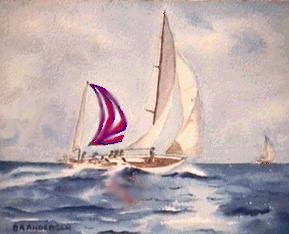
Betty Ann Anderson

This article, which has not yet been updated since 1990, has served over the years as the basis for articles appearing in the "Chasse-Marée", "Classic Boat" and "Die Yacht". As Stormy Weather is not just one of the most famous yachts of this century, but was designed and built in the United States, and that no American publication has yet seen fit to write of Stormy Weather's latest twenty years, all rights and copyright are strictly reserved. Enough material has now been accumulated for a book, but in the meanwhile, we trust that you enjoy . . .
| Sparkman & Stephens design No. 27 (1933) | |
| LOA 53'11" | Displacement 20 tons (empty) |
| LWL 39'8" | Sail area 1300 sq.ft. (working) |
| Beam 12'6 1/4" | Sail area 3316 sq.ft. (max) |
Ocean Racing started at one o'clock in the afternoon of Tuesday 11th December 1866 off Sandy Hook, New York. Three gentlemen owners of fast schooners, the smallest of which measured 105 feet, each bet the others thirty thousand dollars that their vessel would be the first to the Isle of Wight. The owners of the Vesta and the Fleetwing stayed warm and snug at home - after all it was the gale season - but James Gordon Bennett Jr. was aboard his Henrietta with Bully Samuels (see footnote 1), the ranting, roaring ex-master of the Liverpool packet Dreadnought, and a crew of thirty men in all. Henrietta, in just under fourteen days, won the ninety thousand dollars and the race; Fleetwing was second, minus four crew and two quartermasters swept overboard, and Vesta was third after losing her way at the Needles. Such was the Great Race of 1866.
In 1905, the tiny Scotsman Charlie Barr skippered the 185 foot, three masted schooner Atlantic to a transatlantic record of just over twelve days and four hours which held

|
|
Betty Ann Anderson |
For the more common of yachting mortals, a new trend was developing in ocean racing. As early as 1906 Thomas Fleming Day, longtime editor of "The Rudder", had been largely responsible for originating the Bermuda Race, basically for small boats and amateur crews, and still organized today on a biennial basis. It was not until 1925 that, in Europe, Weston Martyr, Malden Heckstall-Smith, George Martin and a few other enthusiasts created the Fastnet Race which became international the following year with the first American entry, Primrose IV. The Ocean Racing Club was formed, with a "completed Fastnet" as the sole condition for membership. By 1931, the O.R.C. had become the Royal Ocean Racing Club, it was announced that the Fastnet would become biennial, and the race was won by Dorade, a 52 foot American yawl that had just won the Transatlantic Race to Plymouth in a very convincing manner. After winning class B in the '32 Bermuda Race, Dorade returned in '33, and with Rod Stephens Jr. as skipper in lieu of his elder brother Olin as in '31, cleaned up first place again. Just who were these young Stephens brothers and their remarkable yawl?
Olin Stephens II was born 1908 in the Bronx, New York, a little over a year before his brother Roderick Jr.(see footnote 2) Their father, Roderick Stephens Sr., a coal merchant, moved the family home to Scarsdale, New York, in 1913 where the two brothers attended High School. From 1920 onwards their summers were spent at Barnstaple Bay, Cape Cod, Martha's Vineyard or on Long Island Sound where they taught themselves to sail on a variety of small boats, some belonging to the family. In 1925 they were invited to sail on a couple of 6-meters, and Olin's experiences with Sherman Hoyt on Lanai, a Clinton Crane design, probably influenced his early predilection for the meter type hull form.
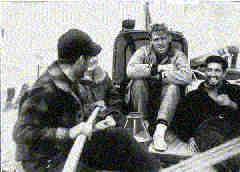 |
|
|
Olin graduated from Scarsdale High in '26 - Rod was then the captain of the unbeaten football team - spent a semester at Massachusets Institute of Technology studying naval architecture, came home at Christmas with a minor bout of jaundice and never returned. Rod's academic career was also short-lived; he started studying engineering at Cornell University, but left to work for Henry B. Nevins, the yard in which Stormy Weather was later built. Olin worked for some time for Henry J. Gielow, then Philip Rhodes, but by '28 his father had arranged a partnership with Drake Sparkman, a yacht broker. Sparkman & Stephens Design No. 1, in the autumn, was for a 21 foot sailboat for the Juniors at the Larchmont Yacht Club, still in use today. Olin designed several small meter boats, including the almost unbeatable 6-meter Goose, but perhaps his biggest break came in '29 when his father commissioned a 52 foot yawl. Dorade was born. Built by Minnefords for $28 000 and launched early in 1930, she was narrow (10' 3" on the beam), floated slightly low to her designed waterline, but was fast, efficient and virtually untouchable on handicap.
By the summer of '33, the yachting establishment in the persons of the Cruising Club of America, keepers of the racing handicap rules, decided that Dorade was not "wholesome"! A narrow beam penalty was introduced and Dorade was partially out of business. Olin, however, had a client who wanted a new yawl - Stormy Weather was born. Very slightly longer, a full twenty per cent beamier, a more powerful turn to her bilges and a little tumblehome to her topsides, a straighter run from bow to ballast and a more refined rudder design, Stormy Weather is nonetheless DORADE's direct descendant, reflecting Olin's life-long love of deep, narrow boats. John Alden, on seeing Stormy Weather out of the water at Nevins' Yard is quoted as saying: "In my opinion a better design would be impossible to achieve." Olin himself said in '73: "During that same pre-war period (as Dorade), the next very successful boat, Stormy Weather,...... In all respects, I liked her not only for her success, but because she was attractive and had a certain character. For her time she was a good all-round boat, best in strong winds, but highly competitive in light going."
Olin Stephens II has designed more than two thousand boats in a career spanning over half a century. He has designed eight America Cup winners (one in collaboration with Burgess), eleven winners of the Bermuda Race, two in the Whitbread Round the World, seven in the Fastnet and many more in the Admiral's Cup, S.O.R.C., Sydney-Hobart..... Yet in a recent interview (WoodenBoat, February '91) his favorite designs were limited to just four - with Stormy Weather heading the list.
Building of Stormy Weather started in very late '33 at the Henry B. Nevins Yard, City Island, New York, and was completed within the following four months. While in the yard she was known as "Mr. X" as her owner, Philip LeBoutillier, had not yet thought of a suitable name. The story runs that just prior to launching, Philip and some friends were having dinner at "The Manor" in Montauk, Long Island, where a young singer sang a song that appealed to him. He called her over and asked that she sing it again. Afterwards, she asked how he liked it. "Liked it?" he said, "You have just named my new boat." Lena Horne's career became just as famous as Stormy Weather's.
Nevins' scantlings, well respected at the time and still used as a yardstick today (see "Skene's Elements of Yacht Design", F. Kinney, editor, published by Dodd Mead, New York) were scrupulously followed throughout. Stormy Weather is basically Philippine mahogany (tangile or Shorea Polyspermia) on New England white oak (Quercus Alba). The frames were steamed on twelve inch centers, sided 2 1/8" - except 3 1/2" by way of the main mast step - and moulded 1 7/8" at the head, increasing toward the keel. The planking is a single thickness of 1 3/8" fastened with Everdur bronze screws. The keel, stem and sternpost are also of white oak, while the horntimber and deadwood are of mahogany. Over 19 000 pounds of lead ballast are bronze bolted to the keel with the center of gravity corresponding to the boat's center of floatation. The eight floors supporting the main mast step and all the hanging knees are bronze. Shelf, clamp and bilge stringers are of Douglas fir (Pseudotsuga menziessii or taxifolia). The deck beams are of spruce (Picea glauca) except those bearing an extra load - mast partners and fore and aft ends of the skylights, hatches and coach roof - which are of oak.
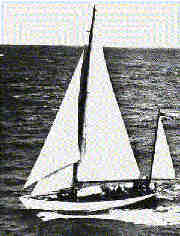 |
|
|
The deck was planked with Port Oregon cedar (Chamaecyparis lawsoniana) in order to save weight, the strakes being 1 3/8" by 1 7/8" payed with black glue except for the cockpit seats payed in white out of deference to the ladies' skirts. Noblesse oblige!
Both masts and booms are hollow, manufactured from sitka spruce (Picea sitchensis), and glued with resorcinol. The main mast carries three sets of spreaders - to allow the use of a genoa jib - and a set of jumpers while the mizzen has one set of spreaders and a single jumper. Two sets of running backstays are provided on the mainmast, only one set on the mizzen. Both the hull and the deck are diagonally strapped with bronze, to avoid distortion of the mast partners. The main chainplates are massive - 5' 4" by 1' 4" by 3/8" everdur bronze plate - let into the frames next to the planking. The lugs (which most readers will probably think of as the "chainplates") were then through-bolted to the planking, main plate, oak backing piece, and the shelf and the clamp where possible! It is no wonder that there is no sign of movement fifty eight years later.
The original powerplant was a Graymarine four cylinder petrol engine of 35 HP driving a 17" by 12" folding two blade Hyde propeller via a vee-drive> It is interesting to note that in 1935 Rod Stephens removed the engine for the Transatlantic and Fastnet Races in order to - his words - "make more room for coal."
All the deck and spar fittings, including the winches, were manufactured from bronze in the foundry at the Nevins' yard, although within a very few years the patterns had been taken overby the new Merriman Company, all parts being interchangable.
The remainder of the equipment was typical of the times - tiller steering, trailing log, coal-fired galley and so on - but there were innovations: the inner forestay was quickly removable by a lever system to allow faster tacking of the genoa jib; a thermometer was permanently installed for sea water temperature readings; the aft companionway was protected by a canvas hood to allow better ventilation in bad weather, although there were many "Dorade" type ventilators; and there were lifelines, but no bow or stern pulpit. Uffa Fox was so impressed that he devoted quite some space to what he called these "gadgets" in his "Second Book".
All in all, Stormy Weather's construction and equipment were strong, efficient and functional, albeit a little lightweight and spartan compared to some of the "gingerbread" of typical contemporary American yachts.
Stormy Weather was launched on the 14th of May 1934, a rather hazy morning, and christened by Mrs Polly LeBoutillier.
Out of thirty one major, well documented ocean races between 1934 and 1954, Stormy Weather won twelve outright, with fifteen firsts in class, nine seconds, five thirds and was disqualified once - the Governor's Cup in Nassau, 1937 - when the whole fleet bar two boats went the wrong way around a mark of the course. The donor of the Cup, Governor Clifford, was on board Stormy Weather at the time!
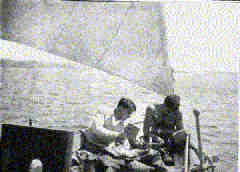 |
|
|
I had known of Stormy Weather for most of my life, by reputation and from the written word, but when I first saw her in the Virgin Islands in the mid seventies it was literally love at first sight. The owners, Doug and Sue White, a youngish American couple, were doing their best to make ends meet in the charter trade. But already modern plastic motor sailers were attracting the majority of customers with promises of hot and cold showers in all cabins, roller furling sails and hydraulic anchor windlasses. And double bunks!
Stormy Weather had also changed over the years. Previous owners had modified and "improved" things. Between 1954 and '65 James J. O'Neill had replaced the main mast, damaged by lightning dockside at the Seawanhaka Yacht Club, with a cut down aluminium spar from a twelve-meter, perhaps VIM; the rig became masthead with a shortened main boom; he had also installed a large Mercedes diesel abandoning the vee-drive, the result being that the engine was in the middle of the aft- (or owner's!) cabin, condemning the aft companionway which became the engine room entrance (Charter guests referred to the bunks in what was left of the cabin as the "coffins"); a 110 volt electrical system had been added for mixers, blenders and hair dryers; three automatic fire extinguishing systems, all non-operational, had been installed to satisfy U.S. Coast Guard passenger carrying requirements; green tennis court carpet had been glued to the deck in an attempt to cure leaks; and more, the horror story seemed endless.
The Whites did their best, living in the forepeak, taking six guests - four in the main saloon and two in the coffins - to lesser known anchorages, cooking gourmet meals on a rather old and problematic kerosene stove. Despite hard work and tender loving care the competition got the better of a somewhat tired classic and a limited budget. By the late seventies, the local banker was getting worried about mortgage payments and I got lucky.....
It took more than a year to assess what had to be done and to prepare for what was evidently going to be much more than patch-work repairs. We took Stormy Weather out sailing one day, with balmy Tradewinds blowing over calm seas. Most of the sails were shapeless, but she moved well after the overheating Mercedes finally came to a stop. A visit below, however, confirmed my fears: the galley furniture had fallen out, and the sky was visible through the planking on the port side where seams had opened gaping wide. We tacked, and the seams closed up with hardly a dribble, but now there was daylight on the starboard side! The final tally was eighty eight broken frames out of a total of one hundred and ten, with all the fractures above the floors and below the bilge stringers; there was no rot, the old steamed oak had blackened and become brittle (see footnote 3).
We removed the carpet from the deck, realizing at once that complete new decking would be necessary. The only rot we found was in a few of the half deck beams in the cockpit area. The engine and interior were removed, paneling and fittings that could be saved were carefully numbered and stored ashore. It became more and more clear that major surgery was the order of the day.
I spent a lot of time at the Sparkman and Stephens offices in New York. Olin had officially retired,but Rod and his colleagues were more than helpful. All the original 1933 drawings were available, with the exception of the dinghy. I wanted Stormy back to her original condition, original wooden spars and sail plan, capable of racing hard and crossing the Atlantic, with the warm glow of oil lamps reflecting on the Mexican mahogany of the main saloon. Rod Stephens was as practical as ever: use modern epoxy laminating techniques for framing and decking:stainless steel for the new mast fittings - he was clear that this would have been used in the thirties, but welding was in its infancy until the enormous advances of World War II: the sails and running rigging would be of modern synthetic materials: a hundred and one details were discussed.
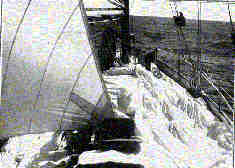 |
|
|
I was scouring lumber yards for sitka spruce, white oak, mahogany and teak for the deck overlay - Port Oregon cedar was just not available. Little by little, everything was shipped to the Virgin Islands; a 12" table saw and a band saw; a fifty gallon drum of epoxy resin; over four hundred pounds of bronze fastenings and rod stock for manufacturing bolts; more clamps and chisels, planes and hand saws, electric cables and copper piping, and a nearly new 25 HP diesel that would fit in properly.
We started in earnest in 1983. "Chippie" Jim Rosenberry, house carpenter Kevin Bosh and little Billy Havlicek - ex aircraft technician on U.S. Navy carriers - put in nearly two years of their lives out of love for the project and a few cold beers in the ice chest, rather than for the pittance wages that I could afford.
The decks were the first priority; rainy season as approaching and we did not need fresh water in the bilges. Redhook, Saint Thomas, was the scene of an ever growing pile of fifty year old cedar deck planking, holly stoned down to less than half an inch in places, and of the start of "Stormy Weather Laboratories" where we started cooking up test pieces of various laminates, teak on ply, oak on oak, some ash for the tiller, all to be soaked in salt water then chiselled apart. We learned how to degrease fresh lumber with acetone, how not to plane the laminates but to pick the correct rip saw blade for maximum adhesion, how to use the natural heat of the sun for epoxy saturation, and what thicknesses of oak could be bent to various radii.
All the deck fittings and associated joiner work was removed with the exception of the coach roof and the main saloon skylight which were raised but kept in place on their bolts. A camber pattern was cut and new main mast partners laminated from oak. The entire cockpit area was gutted and rebuilt, removing a beautifully manufactured, very heavy, but non-original wheel and quadrant steering system. Carlings were replaced and tie-rods checked, old screw holes were plugged and the inner edge of the covering boards was routered. After checking the alignment of the beams, new and old, the first layer of marine ply (6mm) was glued and ringnailed into position, epoxy saturated on both faces, all the butt joints over beams, nibbed in around the roof and skylight bolts and butted to the covering boards. Then the second layer (8mm) was put down with the butt joints staggered over different beams, and the edges routered one inch into the covering boards. We stopped work on the decks at this point, not wanting to damage the teak overlay.
Everything had so far been done on the mooring; we had no haul out facilities and minimal space on shore. So we towed Stormy Weather up to Nanny Cay in Tortola (British Virgin Islands), where she became a semi permanent fixture either on the end of the work dock, next to Finisterre (Carlton Mitchell's Sparkman and Stephens designed centerboard yawl, three times Bermuda Race winner in the fifties), or hauled out alongside the machine shop. During our stay the work dock became quite famous for classics, amongst others Frank Lotito's Nordwind, Frank Pierce's Whirlaway, and Mark and Vicki spent months rejuvenating Temptress.
Reframing was a long, hot and very sticky task. After rechecking the fairness of the hull lines - more or less a partial relofting - we attacked them by pairs, port and starboard, to avoid any distortion which was a major concern in the dry tropical conditions; we even went to the lengths of rigging a sea water hose down system to maintain a proper level of humidity in the mahogany planking. Firstly, each pair of frames was cut out, the old fastenings discarded and the floor, shelf and clamp bolts copied out of bronze stock. Oak laminates were then quarter sawn to the correct length and thickness to be sprung into place. After epoxy saturation, each laminate was glued and ring-nail;es into position, using a minimum quantity of micro-fibers in the resin, an occasionally requiring some bracing and shoring while the epoxy cured. Lasly came the refastening; driving and plugging the screws was long, hard work but posed no major problem compared with drilling the bolt holes in line with those in the original floors, shelves and clamps.
It was a lengthy - four month - messy job. I had to give the crew hair cuts, not because of a somewhat hippy look, but just to remove cured epoxy, which, as we had to work nearly naked (see footnote 4) because of the heat, seemed to get all over us. But those hair cuts were nothing compared to what ensued one day when little Billy sat down in fresh epoxy on a new frame....
While out of the water, we did very little recaulking, not being sure how the planking would reswell once back in again. Obvious spots were taken care of, oakum below the waterline, cotton above.
After relaunching - a great day in itself - the engine and electrics were installed. Both water tanks and the diesel tank, made of tinned copper, riveted and soldered, were steam cleaned, pressure tested and refitted. After belt sanding and resaturating the surface of the deck ply - ultraviolet rays tend to break down any epoxy and this had been in the tropical sun for many months - teak strakes, 1 7/8" by 1/2", were layed in epoxy and micro-fibers, starting at the routered edge of the covering boards, using stainless steel self-tapping screws as temporary fastenings while the glue cured and wedges between the strakes for the "false" seams. When the mid point of the deck was reached, a mahogany "false" kingplank was nibbed in, the stainless screws removed and their holes plugged.
It was at this point that in hindsight I made a big mistake - the seams were filled with epoxy tinted white in the cockpit an with black graphite elsewhere. Over subsequent years the epoxy has cracked, and while it is only a cosmetic problem, a more elastic compound would have been preferable.
We then rebedded the coachroof, skylights and hatches in a polysulphide compound and used a belt sander for finishing. Deck fittings came next, and finally three coats of natural teak oil gave us a "proper yacht" appearance.
Meanwhile the new mainmast, made at Bill Cannell's American Boat Yard in Camden, Maine, had been shipped down to us, with great difficulty - all seventy three feet of it - finally arriving in Nanny Cay on an inter-island freighter at the height of the Charter Boat Show, to the great consternation of all the "million dollar boat" owners and skippers! We had already made the new main boom and stripped and revarnished the original mizzen mast and boom, which had been painted with aluminium stove pipe enamel to match the previous main spar. The fittings and rigging were made up locally, the sailmakers warned that we would soon be ready .....
In January 1984, with no interior and limited deck fittings, Stormy sailed again. A letter from Sparkman and Stephens reads:
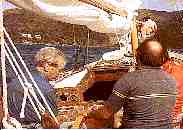 |
|
|
27 January 1984.
Dear Paul:
First and foremost, I would like to thank you so much for that
lovely, if short, sail and I want to congratulate you and all
others involved for the tremendous headway you have made in
restoring Stormy Weather to her 1935 condition.
/ . . . . . /
Please give my best to those boys who put in so much hard work
and hang in there, and I look forward to seeing you later on.
Kind personal regards. Sincerely,
Roderick Stephens, Jr.
And that seemed to make it all worthwhile.
The deck layout was probably the easiest to finalize as we had the original drawing plus Rod's suggestions and also went out sailing and racing as often as possible. Every one of the 1933 Nevins winches were in perfect working order, but it was decided that two large three speeds would be needed in the cockpit. Lewmar had a couple left over from the previous year's America's Cup and supplied them with custom produced bronze drums. The two redundant Nevins winches were donated to Mystic Seaport Museum for the schooner Brilliant, the only other "big" boat, at 61 feet, that Olin had designed between Dorade and Stormy Weather. Two self-tailers were also added near the foot of the main mast to facilitate reefing and spinnaker control. The only discordant notes from the original are the aluminium spinnaker poles - one day they will be replaced; we have the bronze fittings - and the bracket for the Aries windvane mounted inside the boomkin. New sliding hatches were made for both companionways and a copy of the dodger fitted to the aft one, the new dodger being folding rather like a pram-hood. In all but the worst weather we hardly need the canvas hatch covers.
Below decks took a lot longer. The obvious starting points involved plumbing, electrics, mechanical items and safety gear. Early on it was decided that a little "modernism" was required: a completely independent electrical system was installed for the engine - 90 amp-hour battery with its own alternator (55 amp) and cut off switch - the house batteries being two banks of deep-cycle Surettes (250 amp hours each) fed by a 100 amp alternator. I also wanted mechanical refrigeration, so the front end of the engine was rebuilt for the two alternators and the compressor. The battery boxes, inner linings of the ice boxes (one refrigerator, one deep freeze) and the pan in the bottom of the heads were built out of GRP - normally blasphemy on board. A minimum of five inches if thermal insulation went around the ice boxes - copies of the originals - as less space, more efficiency was the word of the day. It now takes the deep freeze five days to thaw out completely, even though running time for electricity and refrigeration is rarely more than forty five minutes a day.
The electrical system was protected by thermal circuit breakers. New, or nearly new electronics included wind instruments - there is nothing worse than a crick in the neck after hours of concentrating on a masthead pennant - communication and navigational equipment. Although I use my sextant regularly, I strongly believe that some electronics, once their limitations have been fully understood, give the skipper more time for his other duties. Satnav, loran-c, decca and R.D.F were installed, but not radar, the latter for two reasons: technical progress and mass marketing were and still are making such tremendous headway that it was easy to say that tomorrow would bring a better and less expensive product (GPS falls into this category also); also the mizzen was original and had lost some wall thickness over the years, so putting the weight and windage of a radar aerial up aloft had me somewhat worried.
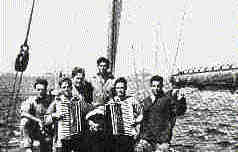 |
|
|
Safety equipment was as much influenced by the Royal Ocean Racing Club's requirements as by the Board of Trade - at the time, memories of the '79 Fastnet were fresh. Four bilge pumps were installed, two electric and two manuals, one in the cockpit and one below. The eight man liferaft and the flares are below, next to the aft companionway, in a dedicated, dry locker, with the life jackets, safety harnesses, ditty bag and solar still. More than adequate ground tackle found its home in the forepeak, not all the way forward, rather than on deck. Double lifelines, jackstays for the harnesses, bow and stern pulpits, side ans stern lights at deck level plus a masthead tri-colour, twin horseshoes...... completed what has, thank goodness, never proved necessary.
The layout below, according to the original drawings, was saved - if not the actual lumber, at least the spirit with very minor changes. Starting forward, the forepeak, originally the home of the paid hand with two single berths in vee, has seen the port berth widened slightly to make a "very cosy" double, and the starboard one reinforced to make a work bench with storage under. The galley is next aft, the only changes from 1934 being the holding plates in the ice boxes, and the inversion of the stove and the sink - we installed a gimballed propane cooker with oven forward to port, and a double sink next to the main mast where the coal stove had once been. Despite criticism of the galley forward, we have never gone wanting for a hot meal at sea. The bulkhead between the galley and the saloon had to be completely replaced, so I took the opportunity of opening up the ventilation by creating an elipsoid cut-out in what is otherwise a structural member supporting the galley and saloon furniture. Nowadays, most guests on board believe this to be original, not knowing that the paid hand was really cut off from the owner's quarters.
The main saloon, navigation table, lobby and toilet room - to use the names on the 1933 drawings - are the most original - we saved nearly all the old panelling; only the leaded glass cupboard door over the buffet and the sink in the heads needed replacing.
The aft cabin - owner's quarters - used as the engine room, had to be entirely rebuilt, only small pieces of the original furnishings remaining. Knowing that I would be spending most of my time living aboard, I changed the original two single upper berths with settees to a double berth to starboard, with storage for the safety equipment beneath and a leecloth to convert it to a single at sea. On the port side I moved everything nearly three feet aft,converting the bunk into a bookself,the settee into a sea-going pilot berth at the end of which I can sit facing forward to a (not original ) table where I can sit comfortably with my charts, or typewriter........
The space under the cockpit is still used for sail storage - we try not to use the racing sails for cruising - and gives access to the packing glands on the drive shaft, offset to port, and the rudder stock.
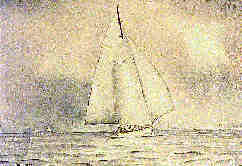 |
|
|
Most of this restoration was carried out prior to 1986; but wooden classics are a never ending source of "let's do this ", or "why didn't we do that before" or even "Oh my goodness, I've got to fix the ???". For the last several years we have hauled in Venezuela where old-fashioned craftsmen are still available without needing a tax write-off! We have replaced bulwarks where modern genoas have made a mockery of the car-tracks; the main mast step whose original white oak was more than tired; and six years after we left the planking to swell we recaulked below the water line. Rod Stephens was always proud to tell me that Stormy's bilges were dry. I can say the same thing now.
Stormy Weather has now logged over one hundred and fifty thousand miles, crossed the Atlantic fifteen times - including a couple of single handed passages; we have won a lot of races, placed in many more; we have had an awful lot of fun cruising, and have always encouraged youngsters to come and experience an older classic; I live on board, cruising, racing, entertaining in a proper ambiance....
When I'm asked what my next boat will be, I reply: "I beg your pardon.... What?"
Stormy is still going strong and has now completed a quarter of a million sea miles and over thirty Atlantic crossings. In August 1995, to celebrate the Sixtieth anniversary of her Fastnet win, she participated yet again - her 7th Fasnet - and was First in Class and Sixth Overall in a fleet of more than two hundred yachts.
Footnote 1:- The Dreadnought, of the Red Cross Line, was maybe not the fastest, but was probably the best known of the transatlantic packets. Built 18?? at Newburyport, Mass., fairly big for her times at 1413 register tons, she once sailed from Merseyside to New York in 19 days. She was wrecked off Cape Horn in 1869. The shanty "The Dreadnought", of which three verses were first published in 1896 by Rudyard Kipling in "Captains Courageous", was a forebitter and a capstan shanty and has as last verse:-
Here's a health to the Dreadnought and to all her brave crew,
Here's a health to Captain Samuels and officers too.
Talk about your flash packets, Swallowtail and Black Ball,
But the Dreadnought's the clipper to beat one and all.
Captain Samuel "Bully" Samuels was Master for the first ten years and wrote in his memoirs "From Forecastle to Cabin":-
"The Liverpool packet sailors were not easily demoralized. They
were the toughest class of seamen in all respects. They could
stand the worst weather, food and usage, and put up with less
sleep, more rum and harder knocks than any other sailors."
But he added:-
"They had not the slightest idea of morality or honesty, and
gratitude was not in them. The dread of the belaying pin kept
them in subjection. I tried to humanise their brutal natures
but the better they were treated the more trouble my officers
had from them".
Back to the text
Footnote 2:- Olin, 13 April 1908; Rod 7 August 1909.
Back to the textFootnote 3:- we have seen this condition on other boats of the same vintage. It is probably provoked by overheating the frames in the steambox, which obviously helps in lofting them, but does not ensure longevity. In extreme cases, the oak looks like coal and can easily be shattered with a hammer. It does not seem to appear before about forty years after steaming.
Back to the textFootnote 4:- Health warnings about skin contact with epoxy products were not very prevalent in those days. Despite the fact that none of us suffered any harm, protective clothing is probably a good recommendation.
Back to the text| Visitor #
|
||
| Revised (T) 26 Feb 98 | Copyright © 1996. All rights reserved |